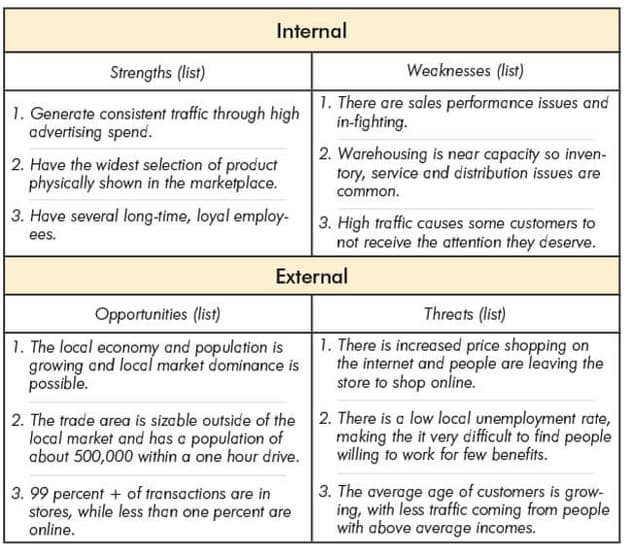The difference between a retail operation that excels and one that produces average results year-over-year most often comes down to one factor: Focus! There are many furniture retailers that employ the highest paid people and are still unsuccessful because they don't have focus. They may have good intentions, but operate ineffectively because this lack of focus allows them to become distracted by what is "urgent" instead of what is really important. Alternatively, top performing businesses focus on the right things. They do not allow themselves to be distracted by events that take them away from working on the truly important areas of their business.
So, how do you know what to focus on in the first place? Is it possible to achieve a crystal clear picture of where you want to go? And where can you apply resources efficiently to get desired results?
One common way of honing your focus is through a SWOT analysis, or Strengths, Weaknesses, Opportunities, Threats. We use SWOT in our performance groups and with consulting clients. If you want to benefit by having better business focus, I suggest that you conduct a SWOT analysis as follows.
The Four Parts
First, understand the four parts:
Strengths: List the things your organization excels at doing. These are value-added activities that comprise your competitive advantage.
Weaknesses: List the aspects of your business that detract from your value or place you at a competitive disadvantage.
Opportunities: List favorable external factors or opportunities in your marketplace.
Threats: List external threats that place your business model at a risk.
Note that SWOT is broken down into two segments: Internal Strengths/Weaknesses and External Opportunities/Threats. This makes explicit the elements inside the walls of your operation that add or detract value. Additionally, this allows you to observe factors in the marketplace outside of your operation that may hurt or help the future success of the business.
Once you've listed these internal and external segments, you can work to develop a strategic direction and use your resources more effectively. It helps you to set specific tactics, and direct day-to-day actions, so that your people focus on doing the right things, at the right times, efficiently.
To illustrate this, let's look at an example from an actual consulting client:
Case Study, Company X
Company X has a two-store operation in a city of 150,000 people. Its annual sales are $15 million with a gross margin of 48 percent and net income (before tax) of three percent. Company X is a third generation family business selling a mix of stocking merchandise and special orders at a wide range of price points. They have four main physical competitors in their trading area, are the largest advertiser of all the businesses in their market and the most highly trafficked operation.
A simplified worksheet of the type used to conduct a SWOT analysis is presented in the chart below (top three points presented).
Going through this exercise, a business strategy and specific tactics were developed to help focus the operation on a specific goal.

Strategy Statement
The strategy statement for Company X specified a goal of achieving sales growth of 15 percent in annual sales volume while building margins to 50 percent overall. The key metrics to focus on were sales per guest recorded by salespeople, and actual sales per visual counter traffic. The team was tasked with reducing the discrepancy between these two metrics. Overall sales per guest became the prime focus for improvement of the entire business. This was to be accomplished while holding advertising at the current dollar spend, and shifting the dollar mix to more digital media.
Tactics For Company X
The top three tactics to accomplish this strategy were defined as follows:
- Hire dedicated sales managers and focus their efforts on defining selling systems for the salespeople to execute.
- Hire the appropriate number of salespeople for the traffic produced, and train them to execute the new selling systems. Eliminate any poisonous attitudes on the current team, and hire for attitude and personality.
- Invest in employee training and benefits.
Results
There were many other points that came up in the SWOT analysis of Company X, but the aforementioned areas were identified as the key ones that could help the business to make the largest improvements. It was obvious that this operation was under-performing when compared with its competitors. Employees had lost focus on their customers with negative effects. Company X was in a perpetual state of chaos-management. A refocus on customers with adequate staffing levels and quality attention was determined to be the new direction. Company X is located in a healthy market with lots of growth potential. The only way it could realize this potential was to develop a more highly functioning team and better managed processes to serve customers.
Conclusion
SWOT Analysis is a simple way to open eyes and possibly save businesses like Company X from implosion. Dollar-wise, achieving the new strategic goals added $1.425 million in gross margin dollars to Company X's bottom line.
If you feel that your operation lacks focus or is confused about which direction to go, try conducting your own SWOT analysis.